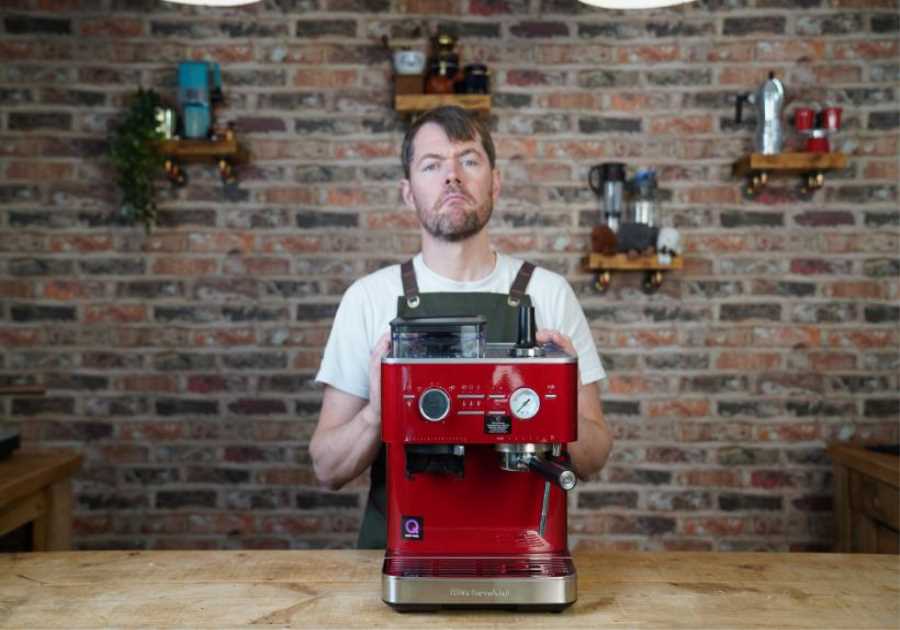The AeroPress is one of the most widely used and enjoyed brewers in the coffee industry. Its versatility has led many people to create their own unique recipes, many of which can be seen on stage at the annual World AeroPress Championships.
Although there are many variables involved in developing your own AeroPress recipe (such as dose and total brew time), grind size is arguably one of the most important. By selecting the right grind sizes for your recipe, you will be able to extract the best characteristics from your coffee.
To find out more about different grind sizes for the AeroPress, I spoke with two coffee professionals. Read on for more of their insight.
You may also like our article on how AeroPress recipes have changed in recent years.
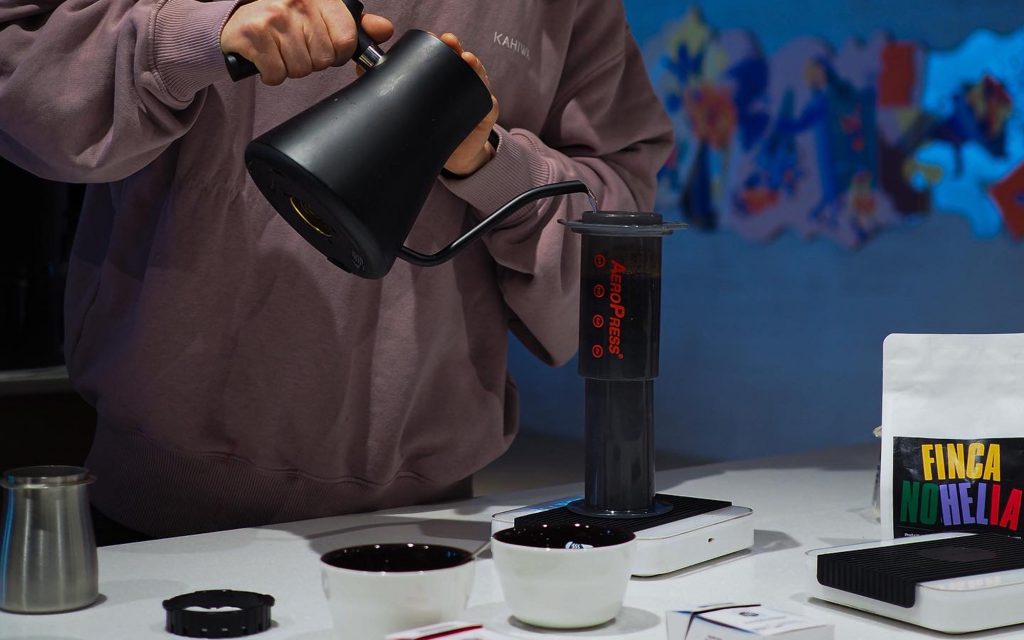
Choosing your initial grind size
Tuomas Merikanto is a barista at Kahiwa Coffee in Lahti, Finland and the 2021 World AeroPress Champion.
He explains some of the general qualities of coffee which has been brewed with an AeroPress – although it’s important to note that these can vary depending on the coffee you use.
“The coffee’s body is usually between medium and heavy, and it has fuller-bodied flavours because of the pressure created from the AeroPress – somewhat similar to espresso,” he says. “The filter prevents fine particles from being extracted, so it tastes cleaner than espresso.”
Considering how the AeroPress extracts coffee, there are a number of variables you need to take into account, but finding the right grind size is one of the most important steps.
Ultimately, the grind size will significantly influence the extraction of flavours and aromas, so choosing the right one for your recipe will ensure your coffee isn’t under or overextracted.
Constance Romero is a Marketing Associate at AeroPress. She suggests a good starting point for finding the right grind size.
“The original AeroPress recipe calls for a relatively fine grind size which is slightly more coarse than what you would use for espresso,” she says.
In order to pull high-quality espresso shots, baristas need to grind coffee to a very fine size. This increases the surface area of the ground coffee, meaning more volatile compounds can be extracted during the shorter brew time.
However, grinding too fine can result in overextraction. This is when too many flavour compounds are extracted – resulting in a bitter-tasting coffee – so you need to ensure your grind size isn’t too fine for the AeroPress.
For more general guidance, Tuomas suggests slightly changing your initial grind size based on the roast profile of your coffee.
“I have my go-to recipes for AeroPress, and I choose which one to start with based on the coffee’s roast profile,” he tells me. “For example, [I would grind finer for lighter roasters].
“But I like to try different recipes for different coffees, and see how the coffee changes using different recipes,” he adds.
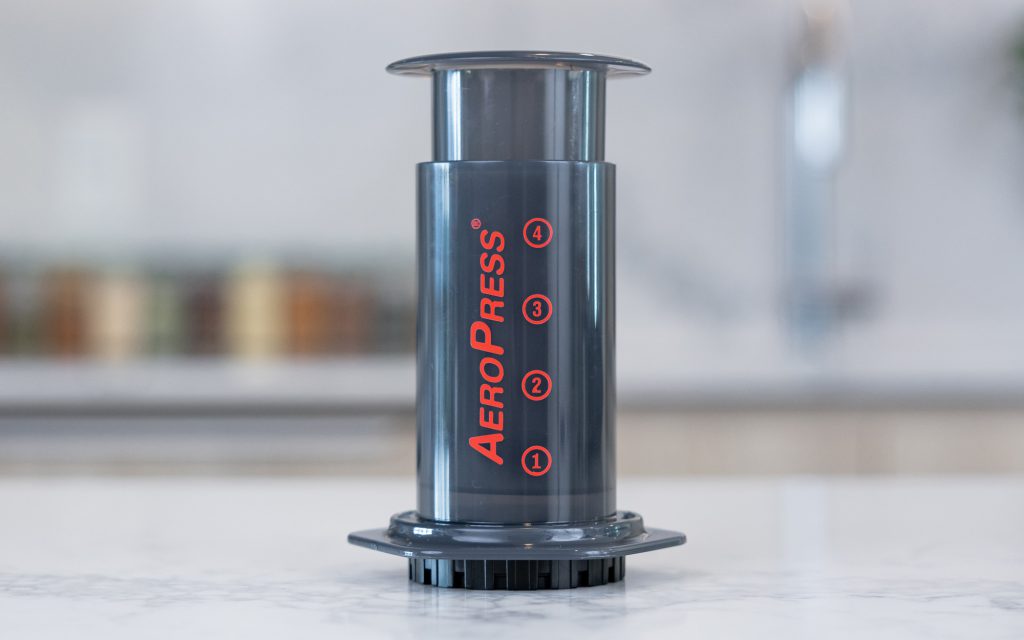
How does grind size affect flavour?
To understand how and when to change the grind size for your AeroPress recipe, we first need to explore how different grind sizes affect flavours in coffee.
No matter which brewing method you use, grind size will have a big impact on flavour. And while the AeroPress is regarded as a more versatile brewer than others, it’s still important to have an in-depth understanding of the impact of your chosen grind size.
“There’s a relationship between grind size and total brew time,” Constance says. “With smaller particles, you need to brew the coffee for less time.
“Conversely, the coarser your grind size is, the longer your total brew time should be,” she adds. This is because the ground coffee needs to be in contact with the brew water for longer in order to extract enough volatile compounds.
However, there are a range of different factors to pick between when choosing the right grind size – which include origin, variety, processing method, and roast profile.
“Finer grind sizes can result in a more pronounced body, as well as a rounder texture and mouthfeel, compared to coarser sizes,” Tuomas says. “They also tend to brew coffee which is more concentrated in flavour, so fruity and sweet characteristics are highlighted, but at the same time, more astringent and acidic characteristics can be overpowering.”
In essence, this means knowing which grind size is right for you will be based on a number of factors. For instance, coffees that have been experimentally processed may require some adjustment, and may even need to be ground finer to account for the various difficulties that may arise when brewing them.
However, it’s important to note that this also depends on the coffee you’re using, as each one is different, as well as your own personal taste preferences.
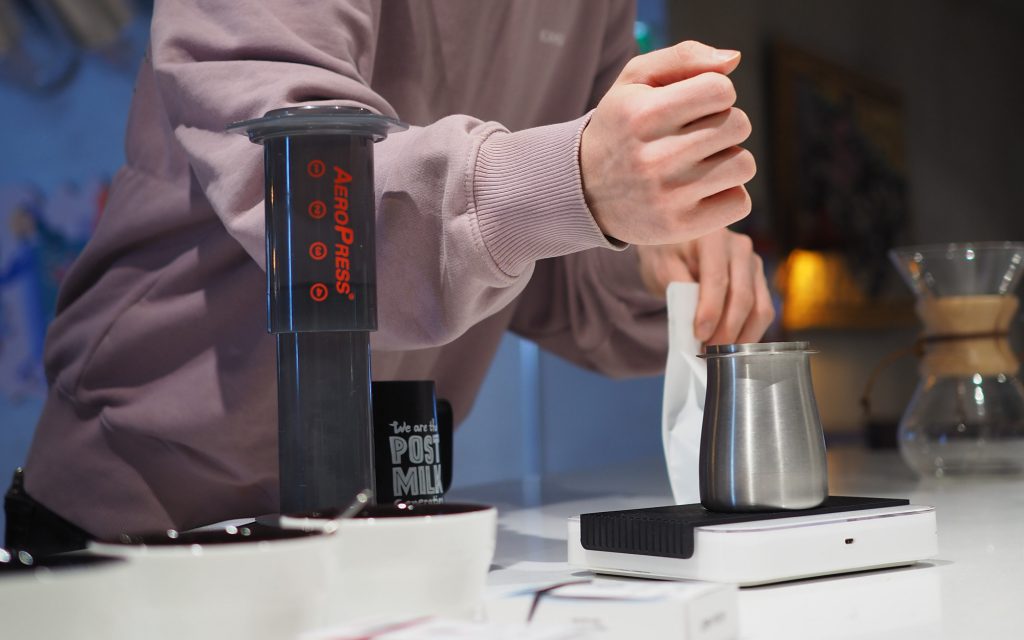
How should you adjust your grind size?
Once you have a clearer understanding of how the coffee you are using will influence your grind size, you can then develop and refine your AeroPress recipe.
The flexibility of brewing with the AeroPress means you can use a wider range of grind sizes, but this ultimately comes down to the type of coffee you’re brewing with.
“The right grind size comes down to the different brewing variables and the overall recipe,” Tuomas explains. “Firstly, I decide whether the particular coffee could work as an espresso-style drink.
“If it can, then you have more room to experiment with different grind sizes,” he adds. “Fuller-bodied coffees can work better as espresso-style drinks, which require finer grind sizes, so it will be harder to push down on the AeroPress.”
The AeroPress creates a vacuum when brewing, so the buildup of pressure in the brew chamber means a certain amount of force is required to push the plunger down. In general, the finer the grind, the more compact the coffee grounds will be, and as such, more force will be required to push the plunger down and extract the coffee.
“Brewing with a coarser grind, meanwhile, will reduce the force needed to press the plunger,” Constance tells me. “With finer grinds, the user should let the coffee steep for at least one minute, and up to three minutes, so that they don’t need to push the plunger down too hard.
“We often find that a more gentle press will create a more balanced cup,” she adds.
Tuomas says: “If a coffee has a lighter body and more delicate flavours, then I wouldn’t brew it as an espresso-style drink – they tend to taste too harsh.
“But there are always exceptions to the rules, so be curious and experiment,” he adds.
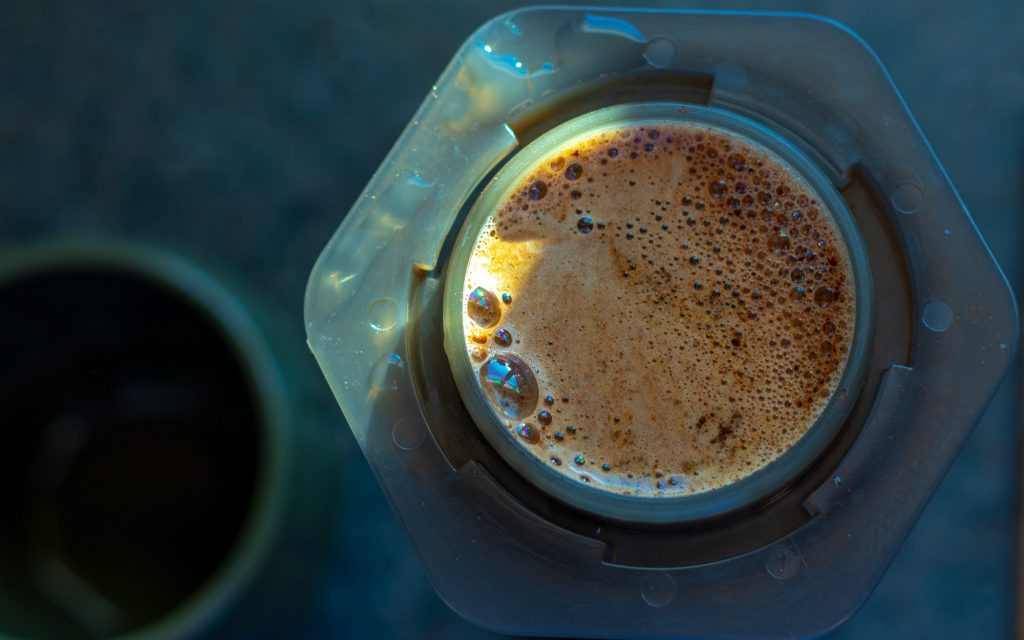
Experimenting with your recipe
In order to improve your AeroPress recipes, both Constance and Tuomas agree that experimenting with different variables is key – including grind size.
“To brew excellent coffee, you should always use high-quality coffee and fresh water,” Tuomas says. “In the World AeroPress Championship, competitors have to work with the coffee and water they are given, but they can change the brewing variables as much as they want.”
Constance tells me: “Play around with different variables. There are very few wrong ways to brew with an AeroPress, so if the coffee tastes good, you did it right!”
Tuomas shares two of his favourite AeroPress recipes with us below – the first is his award-winning 2021 World AeroPress Championship recipe:
Inverted method
- Water: 200g at 80°C (176°F) (Tuomas used a mix of distilled water and 100% Third Wave Water Espresso)
- Coffee: 18g, medium-coarse
- Two AeroPress paper filters
- Add the ground coffee to a pre-heated AeroPress chamber.
- Between 0 and 0:10 seconds, add 50g of water.
- Stir the slurry back and forth very gently three times.
- Between 0:15 and 0:30, pour a total of 200g of water.
- Between 0:30 and 0:50, stir the slurry and leave to brew.
- Around 0:50, stir the slurry very gently three more times.
- At 1:00, attach the filter cap with two rinsed paper filters, push out any excess air, and allow to brew for 40 seconds.
- At 1:40, flip the brewer onto a receptacle.
- Slowly push down on the plunger until 2:00.
- Swirl the brewed coffee for 30 seconds and pour into another receptacle or mug.
- Serve and enjoy.
The second recipe is from Tuomas’ 2021 Finnish AeroPress Championship routine:
Inverted method
- Water: 200g water at 95°C (203°F)
- Coffee: 11g, coarse-medium
- Two AeroPress paper filters
- Add the ground coffee to a pre-heated AeroPress chamber.
- Start with a fast and aggressive pour of 60g of water, and stir quickly for 15 seconds.
- Pour the remaining 140g of water into the brew chamber.
- Attach the filter cap with two rinsed paper filters and remove any excess air.
- Brew for a total time of 2:10, light swirl the brewer, flip onto a mug or receptacle, and push down for 20 seconds.
- Serve and enjoy.
Although experimenting with this recipe should be enjoyable, brewers need to be aware that each grinder is different, and may well produce varying results.
“Some grinders result in too many fines, while some grinders can’t grind fine enough, so the size may be coarser than you would like,” Tuomas explains. “If you want your coffee to taste good, you need to use a high-quality grinder.”
Constance, meanwhile, tells me that different types of burr sets will also influence flavour.
“Flat burrs typically improve flavour clarity, while conical burrs enhance mouthfeel and complexity,” she says. “Results will also vary between roast profiles, brew recipes, and the speed at which you push down on the plunger.”
Finally, Tuomas notes the importance of using good quality water to brew excellent coffee.
“Water is one of the most underestimated brewing variables, so if you have easy access to distilled water or mineral pouches like Third Wave Water, use these rather than tap water,” he concludes.
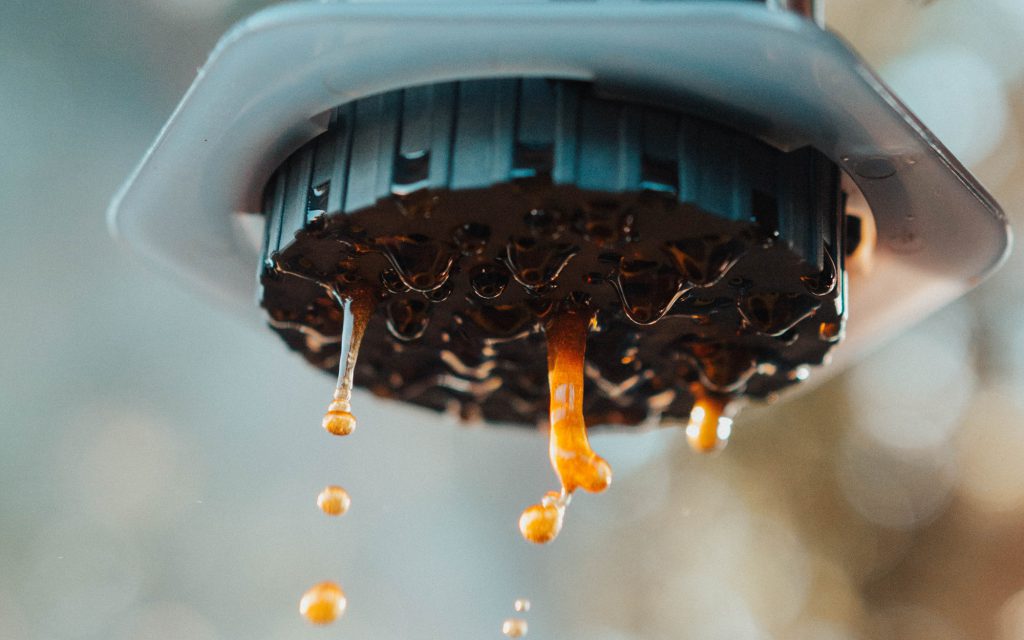
There are a seemingly endless number of brewing variables to consider when making excellent-tasting coffee using the AeroPress, and grind size is one of the most important.
By changing your grind size, you can give yourself more control over how the coffee extracts – ultimately allowing you to find the sweet spot for any coffee you choose.
Enjoyed this? Then read our article on how grind size can help you brew better-tasting coffee.
Photo credits: Artisan Assets, Tuomas Merikanto
Perfect Daily Grind
Want to read more articles like this? Sign up for our newsletter!
The post How can you brew coffee with the AeroPress using different grind sizes? appeared first on Perfect Daily Grind.
By: Thomas WensmaTitle: How can you brew coffee with the AeroPress using different grind sizes?
Sourced From: perfectdailygrind.com/2022/11/brew-coffee-with-the-aeropress-using-different-grind-sizes/
Published Date: Thu, 03 Nov 2022 06:26:00 +0000






